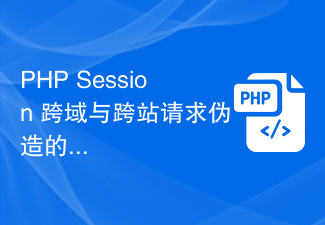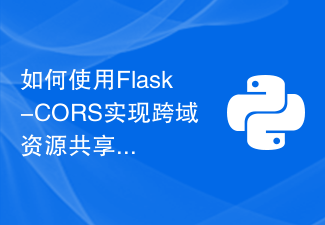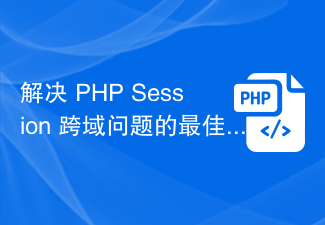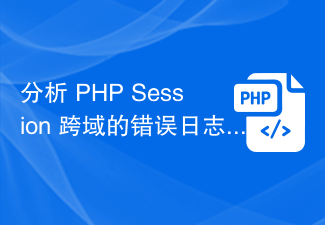
Use PHP Session to achieve cross-domain single sign-on
With the development of Internet technology, Single Sign-On (Single Sign-On, referred to as SSO) has become a popular choice for many websites and application requirements. SSO enables users to authenticate with one login without having to log in again across multiple related domains. In this article, we will introduce how to use PHP Session to implement single sign-on across domains.
Implementing single sign-on requires the following three main components:
- Authentication Center (Authentication Center): Responsible for user login verification and authorization.
- Main Application: The application with main functions.
- Sub Application: Other applications related to the main application.
The following are specific code examples:
Authentication center code example (auth_center.php):
<?php
// 启动会话
session_start();
// 用户登录验证
function authenticateUser($username, $password) {
// 进行用户验证逻辑
// ...
// 验证成功,保存用户信息到 Session 中
$_SESSION['username'] = $username;
// 其他需要保存的用户信息
// ...
}
// 判断用户是否已登录
function isUserLoggedIn() {
return isset($_SESSION['username']);
}
// 用户注销
function logoutUser() {
session_unset(); // 清除 Session 中的所有数据
session_destroy(); // 销毁 Session
}Main application code example (main_app.php):
<?php
// 启动会话
session_start();
// 认证中心的 URL
$authCenterUrl = 'http://auth-center.com/auth_center.php';
// 判断用户是否已登录
function isUserLoggedIn() {
return isset($_SESSION['username']);
}
// 单点登录逻辑
if (!isUserLoggedIn()) {
// 跳转到认证中心进行登录
header('Location: ' . $authCenterUrl);
}
// 获取用户信息
$username = $_SESSION['username'];
// 其他用户信息的获取
// ...
// 主应用主体逻辑
// ...Sub-application code example (sub_app.php):
<?php
// 启动会话
session_start();
// 认证中心的 URL
$authCenterUrl = 'http://auth-center.com/auth_center.php';
// 单点登录逻辑
if (!isset($_SESSION['username'])) {
// 跳转到认证中心进行登录
header('Location: ' . $authCenterUrl);
}
// 获取用户信息
$username = $_SESSION['username'];
// 其他用户信息的获取
// ...
// 子应用主体逻辑
// ...In the above code example, the authentication center is responsible for user login verification and authorization, and the main application and sub-application are used to demonstrate the effect of single sign-on .
When using it, you need to place the above three code examples under their respective domain names, and configure the domain name according to the actual situation. The URL of the certification authority needs to be configured in the main application and sub-applications.
In the implementation of single sign-on, the main application and sub-applications determine whether the user is logged in by checking whether user information exists in the Session. If you are not logged in, jump to the certification center to log in. After the authentication center successfully logs in, the user information will be saved in the Session. The main application and the sub-application can share the user login status through the Session, thereby realizing single sign-on.
Taking into account security factors, in actual applications, it is also necessary to carry out security measures such as identity verification and Token verification on the certification center to ensure user login security and data credibility.
By using PHP Session to implement single sign-on across domains, it can improve convenience and user experience, reduce users’ repeated login operations, and improve the overall user management efficiency of websites and applications.
The above is the detailed content of Use PHP Session to achieve cross-domain single sign-on. For more information, please follow other related articles on the PHP Chinese website!
 PHP Session 跨域与跨站请求伪造的对比分析Oct 12, 2023 pm 12:58 PM
PHP Session 跨域与跨站请求伪造的对比分析Oct 12, 2023 pm 12:58 PMPHPSession跨域与跨站请求伪造的对比分析随着互联网的发展,Web应用程序的安全性显得格外重要。在开发Web应用程序时,PHPSession是一种常用的身份验证和会话跟踪机制,而跨域请求和跨站请求伪造(CSRF)则是两种主要的安全威胁。为了保护用户数据和应用程序的安全性,开发人员需要了解Session跨域和CSRF的区别,并采
 Memcached缓存技术对于PHP中的Session处理的优化May 16, 2023 am 08:41 AM
Memcached缓存技术对于PHP中的Session处理的优化May 16, 2023 am 08:41 AMMemcached是一种常用的缓存技术,它可以使Web应用程序的性能得到很大的提升。在PHP中,常用的Session处理方式是将Session文件存放在服务器的硬盘上。但是,这种方式并不是最优的,因为服务器的硬盘会成为性能瓶颈之一。而使用Memcached缓存技术可以对PHP中的Session处理进行优化,提高Web应用程序的性能。PHP中的Session处
 Vue 中如何进行跨域请求?Jun 10, 2023 pm 10:30 PM
Vue 中如何进行跨域请求?Jun 10, 2023 pm 10:30 PMVue是一种流行的JavaScript框架,用于构建现代化的Web应用程序。在使用Vue开发应用程序时,常常需要与不同的API交互,而这些API往往位于不同的服务器上。由于跨域安全策略的限制,当Vue应用程序在一个域名上运行时,它不能直接与另一个域名上的API进行通信。本文将介绍几种在Vue中进行跨域请求的方法。1.使用代理一种常见的跨域解决方案是使用代理
 如何使用Flask-CORS实现跨域资源共享Aug 02, 2023 pm 02:03 PM
如何使用Flask-CORS实现跨域资源共享Aug 02, 2023 pm 02:03 PM如何使用Flask-CORS实现跨域资源共享引言:在网络应用开发中,跨域资源共享(CrossOriginResourceSharing,简称CORS)是一种机制,允许服务器与指定的来源或域名之间共享资源。使用CORS,我们可以灵活地控制不同域之间的数据传输,实现安全、可靠的跨域访问。在本文中,我们将介绍如何使用Flask-CORS扩展库来实现CORS功
 解决 PHP Session 跨域问题的最佳实践Oct 12, 2023 pm 01:40 PM
解决 PHP Session 跨域问题的最佳实践Oct 12, 2023 pm 01:40 PM解决PHPSession跨域问题的最佳实践随着互联网的发展,前后端分离的开发模式越来越普遍。在这种模式下,前端与后端可能部署在不同的域名下,这就导致了跨域问题的出现。而在使用PHP的过程中,跨域问题也涉及到Session的传递与管理。本文将介绍PHP中解决Session跨域问题的最佳实践,并提供具体的代码示例。使用Cookie使用Coo
 如何在HTML中允许跨域使用图像和画布?Aug 30, 2023 pm 04:25 PM
如何在HTML中允许跨域使用图像和画布?Aug 30, 2023 pm 04:25 PM为了允许跨域使用图像和画布,服务器必须在其HTTP响应中包含适当的CORS(跨域资源共享)头。这些头可以设置为允许特定的来源或方法,或者允许任何来源访问资源。HTMLCanvasAnHTML5CanvasisarectangularareaonawebpagethatiscontrolledbyJavaScriptcode.Anythingcanbedrawnonthecanvas,includingimages,shapes,text,andanimations.Thecanvasisagre
 Vue技术开发中遇到的跨域问题及解决方法Oct 08, 2023 pm 09:36 PM
Vue技术开发中遇到的跨域问题及解决方法Oct 08, 2023 pm 09:36 PMVue技术开发中遇到的跨域问题及解决方法摘要:本文将介绍在Vue技术开发过程中,可能遇到的跨域问题以及解决方法。我们将从导致跨域的原因开始,然后介绍几种常见的解决方案,并提供具体代码示例。一、跨域问题的原因在Web开发中,由于浏览器的安全策略,浏览器会限制从一个源(域、协议或端口)请求另一个源的资源。这就是所谓的“同源策略”。当我们在Vue技术开发中,前端与
 分析 PHP Session 跨域的错误日志处理Oct 12, 2023 pm 01:42 PM
分析 PHP Session 跨域的错误日志处理Oct 12, 2023 pm 01:42 PMPHPSession跨域错误日志处理在开发Web应用程序时,我们经常会使用PHP的Session功能来跟踪用户的状态。然而,在某些情况下,会出现跨域的错误,导致无法正确访问和操作Session数据。本文将介绍如何处理PHPSession跨域错误,并提供具体的代码示例。什么是PHPSession跨域错误?跨域错误指的是在浏览器中


Hot AI Tools

Undresser.AI Undress
AI-powered app for creating realistic nude photos

AI Clothes Remover
Online AI tool for removing clothes from photos.

Undress AI Tool
Undress images for free

Clothoff.io
AI clothes remover

AI Hentai Generator
Generate AI Hentai for free.

Hot Article

Hot Tools

SublimeText3 Linux new version
SublimeText3 Linux latest version

Notepad++7.3.1
Easy-to-use and free code editor

Atom editor mac version download
The most popular open source editor

WebStorm Mac version
Useful JavaScript development tools

ZendStudio 13.5.1 Mac
Powerful PHP integrated development environment






